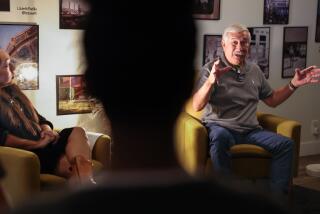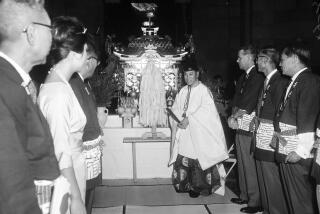Column: Cabrillo landed in California 480 years ago. People have fought over him ever since
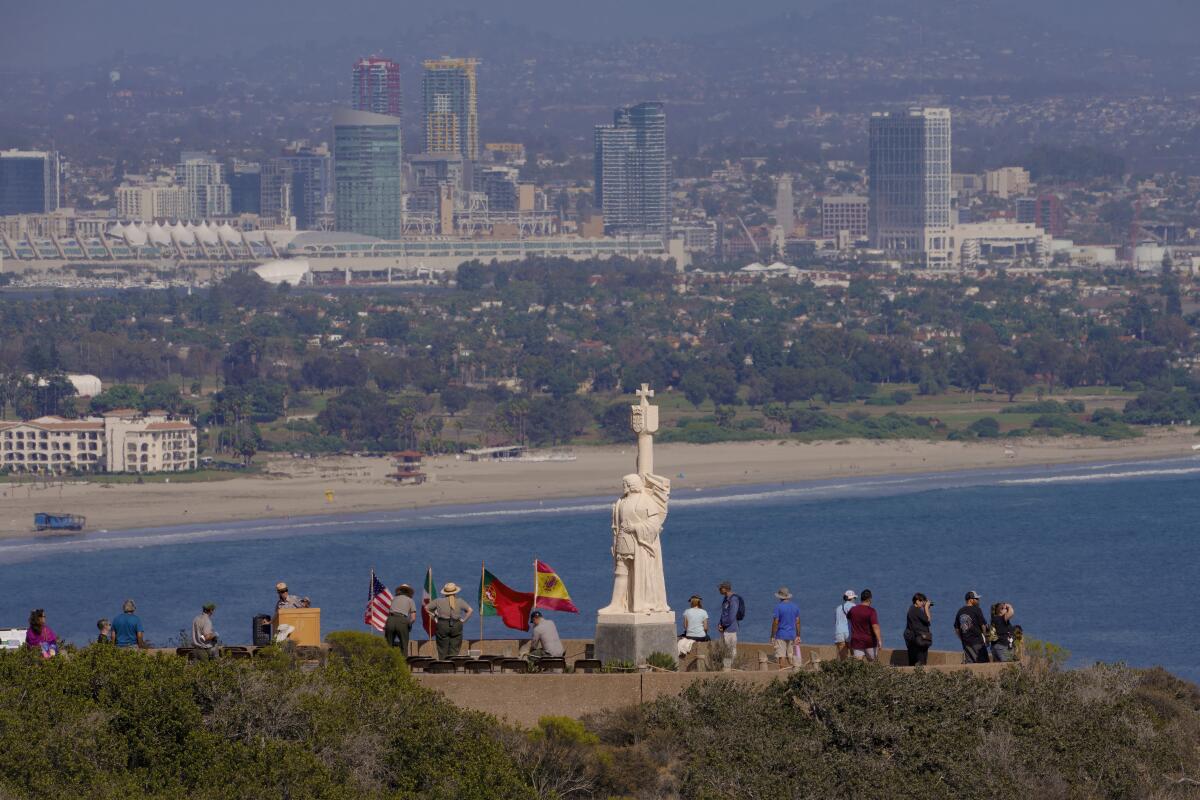
- Share via
POINT LOMA — Wearing a sharp blue suit and a stern look, Jesus Benayas strode to a podium at the Cabrillo National Monument. Behind him was a stunning view of the San Diego skyline. Below, boats bobbed in the bay.
A few feet away, a 14-foot, multiton limestone statue of Juan Rodríguez Cabrillo loomed over Benayas and about 40 other people.
They had gathered on a warm Friday afternoon to commemorate the 480th anniversary of Cabrillo’s landing, near this very spot, on behalf of the Spanish crown. He became the first European to set foot in what’s now California.
Cabrillo National Park Supt. Andrea Compton had started the event by proclaiming, “Our community and many nations come together to celebrate,” then shouting out the dignitaries — politicians, consul generals, members of the U.S. military — in attendance. Everyone rose for the national anthems of the United States, Mexico, Portugal and Spain, as the countries’ flags flapped.
Benayas had no time for diplomatic niceties.
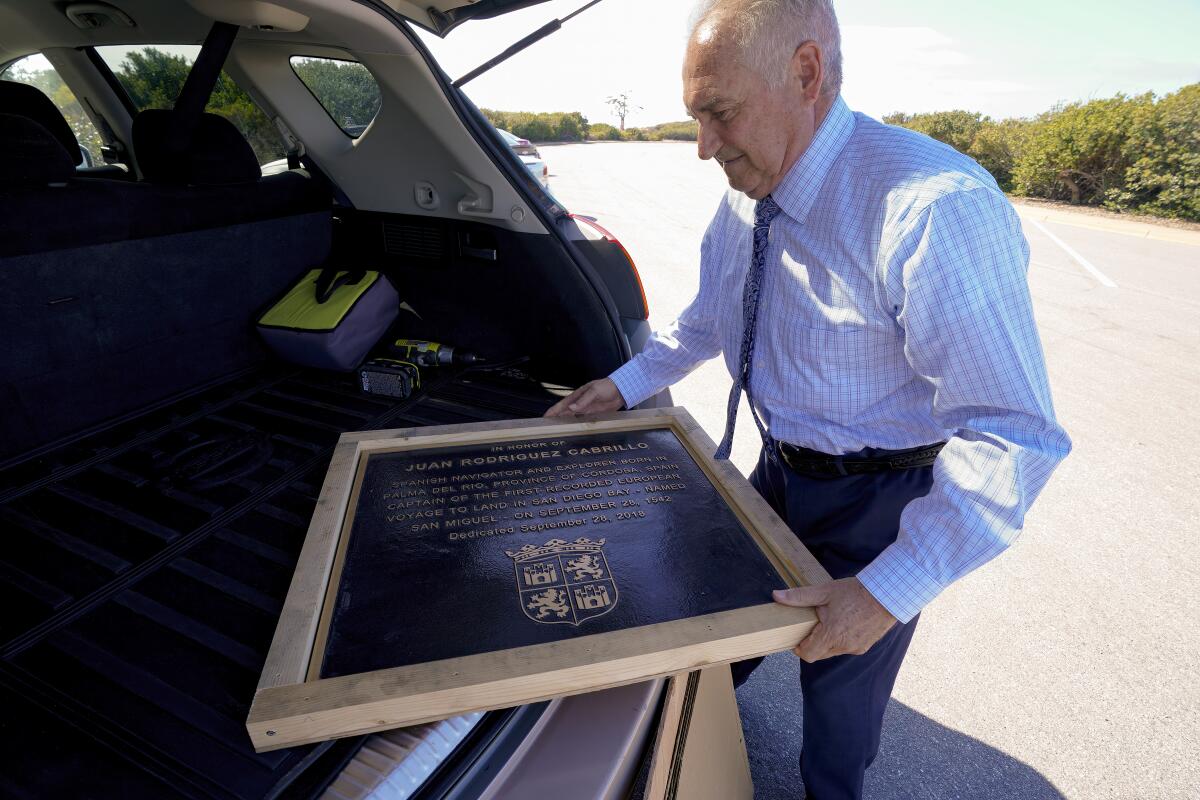
The retired electrical engineer is president of Casa de España, a local nonprofit dedicated to celebrating Spanish culture.
His group had long sold paella from a booth at the Cabrillo Festival, San Diego’s premier celebration of all things Cabrillo. The explorer was a point of pride for the city’s Portuguese community, which had embraced him as one of their own, despite a centuries-old controversy over his heritage.
In 2015, a Canadian researcher discovered that in a long-ago lawsuit, Cabrillo had testified that he was born in Spain. Most scholars now accept that Cabrillo was a Spaniard.
Benayas began to speak, laying out the history of the Cabrillo National Monument and the efforts to verify its namesake’s ancestry in a calm, pointed tone.
The 79-year-old, who moved to San Diego County from Spain when he was 18, didn’t stop or even raise his voice when jets and helicopters roared over him. He described how an American historian dug through the Portuguese National Archives in the 1950s to find concrete proof that Cabrillo was born in that country.
“He,” Benayas said, “found nothing.”
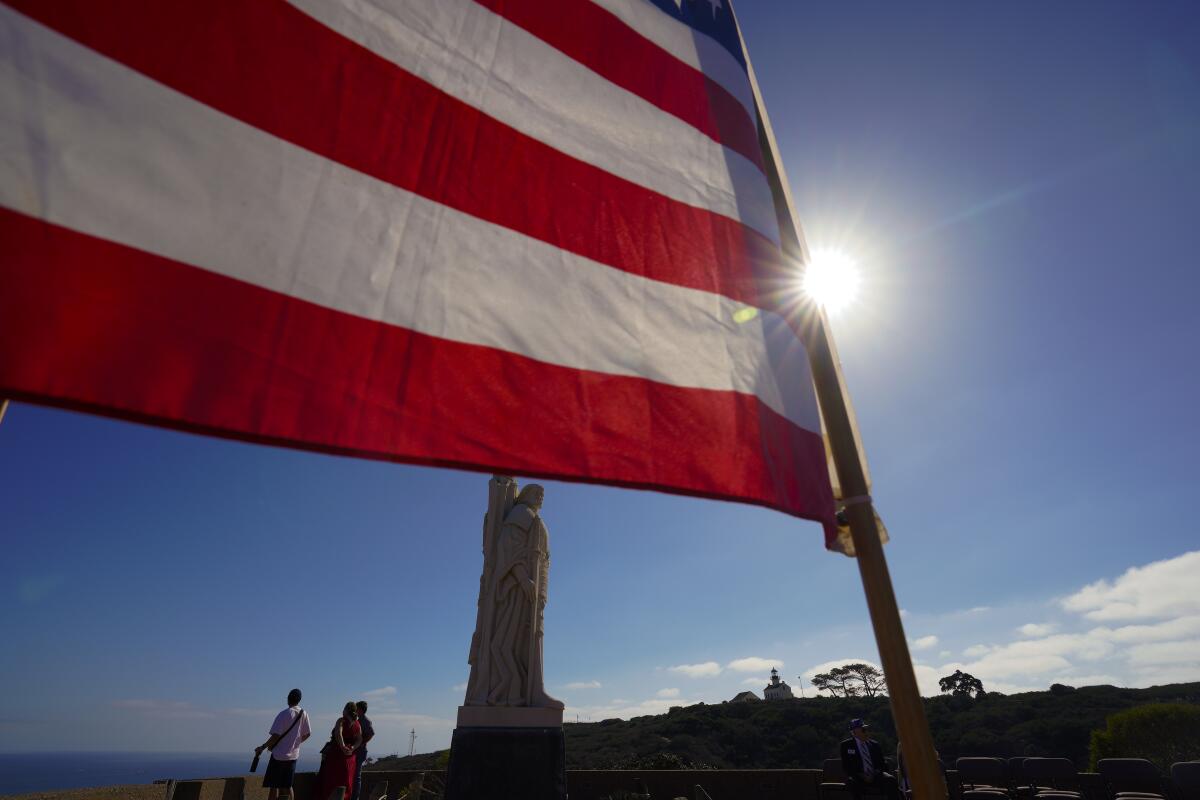
The once-joyous mood of the crowd turned sour. Legs twitched. Lips pursed. The Spanish consul general from Los Angeles crossed his arms, then rubbed his forehead. The Portuguese consul general from San Francisco tapped away on his phone.
Benayas finished by saying that the Cabrillo National Monument and the National Park Service should “correct their own historical errors.”
There would be more applause for a Clarence Thomas speech hosted by an abortion-rights group than what Benayas received.
People stayed away from him afterward, even as they whispered behind his back. Unperturbed, he went to hang out with members of the Spanish air force and army decked out in their dress uniforms.
In 2018, Casa de España spent about $1,500 to cast a bronze plaque noting that Cabrillo was born in the Spanish province of Córdoba.
Park rangers placed it at the base of Cabrillo’s statue, steps away from a 1957 plaque that deemed Cabrillo a “Portuguese navigator” and another donated by the Portuguese Navy in 1988 that stated the same.
But this June, Supt. Compton mailed back the Casa de España plaque — all 60 pounds of it — with a thank you note and an explanation that it was no longer necessary, since a new exhibit mentioned there was “evidence” of Cabrillo’s Spanish roots.
There are now agave plants where Casa de España’s plaque once stood. Yet the plaques claiming Cabrillo as Portuguese remain.
“If we want to talk about decades of lies, we can talk about it,” Benayas told me. “It’s all the truth.”
An eight-year quest to trace the life of the first European to explore the California coast and discover San Diego Bay has resulted in a biography of Juan Rodriguez Cabrillo which will be published this fall by the Huntington Library at San Marino.
“Cabrillo” belongs to a roster of names from California’s Spanish era — Coronado, Serra, Pico, Portola — that have long dominated the landscape.
Hundreds of streets, freeways, neighborhoods, schools, museums, beaches and parks bear Cabrillo’s name. San Diego has marked his landing since at least the 1890s with festivals that have reenacted the feat many times.
In 1913, President Wilson designated the Cabrillo National Monument. About 684,000 people visited last year, according to the National Park Service. In 2015, the Maritime Museum of San Diego debuted a $6.2-million, life-size replica of Cabrillo’s ship, the San Salvador.
But his story is so old, and his visit so brief, that the details are mostly forgotten. After landing in San Diego, Cabrillo’s expedition spent four months sailing up the California coast as far north as Point Reyes, then back down to the Channel Islands, where he died from an injury.
When I stopped by for the anniversary celebration, tourists seem more interested in the panoramic views of the Pacific and hiking trails than the musty visitor center with ratty mannequins dressed in faux colonial-era costumes and an empty movie theater that showed short films about Cabrillo.
For Portuguese Americans across the United States and especially in California, Cabrillo remains a hero. The Portuguese government donated a statue of him that was installed in Point Loma in 1949, replacing it in 1988 with a weatherproof replica that stands today.
Banquets for Cabrillo Day — Sept. 28, the date of his landing in San Diego — still happen across the Central Valley, long the base for California’s Portuguese community.
“I was brought up believing he was Portuguese,” said Joanne Cabral. The 81-year-old is the daughter of a Portuguese immigrant who worked in San Diego’s fishing industry. She and a Portuguese American actor who had long portrayed Cabrillo around town laid a wreath in front of the statue after Benayas’ speech. “And that’s the way it is.”
“We’ll fight until the end,” said Mike McCoy, a Sacramento resident who’s the president of the Cabrillo Civic Clubs of California, the state’s oldest Portuguese American group. He muttered something about new evidence that would show Cabrillo was in fact Portuguese, but he didn’t elaborate.
When I asked why it was so important to quarrel over a long-dead seaman, McCoy gave me the type of smile that uncles give when they’re about to dress you down.
“He discovered us,” he said.
But Cabral, McCoy and their fellow Cabrillians — what Cabrillo fans call themselves — are battling the shifting tides of history.
For 37 years, a San Pedro group has reenacted the 1542 landing of Juan Cabrillo on San Miguel Island.
Patty Camacho is the head of the Cabrillo Festival, which has been on hold since 2019 due to the pandemic. She offered some conciliatory words after Benayas’ fiery words, and continued her charitable approach when I asked how she was feeling.
“History evolves. We learn,” she said. “We respect the past, we respect the present, and we respect what’s coming.”
“The evidence is the evidence,” said 49-year-old Pedro Romon Diaz. The Casa de España secretary stared at the Cabrillo statue, which bore the Portuguese version of the explorer’s name — João Rodrigues Cabrilho — at its base and on the back. “They put the name in Portuguese, but the park is called Cabrillo. Funny, no?”
“People who believe something for a very long time are reluctant to give up their belief,” said Philip Hinshaw, an 87-year-old Navy veteran, Casa de España treasurer, and member of the National Society of the Sons of the American Revolution. “I don’t want to be critical of the Portuguese, but I hope they accept. There were things about the American Revolution that we thought to be true but we now know are not.”
As I was leaving, Benayas said he wanted to show me something.
The U.S.
Before the event, he had handed over a yellow folder. Among its contents: his complete remarks for that day’s commemoration, minutes from a September meeting the Casa de España held with Compton and her bosses at the National Park Service urging them to put the plaque back, and letters the group had sent to Rep. Scott Peters (D-San Diego) and U.S. Secretary of the Interior Deb Haaland asking for help in striking any mention of Cabrillo as Portuguese from the national park.
In a statement, a National Parks Service spokesperson acknowledged Cabrillo’s sworn testimony that he was Spanish-born but said, “We remain committed to following law and policy with respect to the permanent placement of commemorative works and plaques.”
Benayas and I walked to the parking lot, where he opened the trunk of his Nissan Murano. Inside, wedged inside a box, was the Casa de España plaque.
The group refuses to install it in its Balboa Park headquarters or anywhere other than the Cabrillo National Monument.
“I’m not doing this as a Spaniard. I’m doing this as an American,” Benayas said as he closed the trunk. A pin with the Spanish and American flags shone on his suit lapel. “We need to learn our actual history, not imaginary ones.
“I didn’t even care about the Portuguese plaques,” he added. “Now I do. They were fools to return our plaque to us. A double slap in the face. Now, I’m annoyed.”
More to Read
Sign up for Essential California
The most important California stories and recommendations in your inbox every morning.
You may occasionally receive promotional content from the Los Angeles Times.

